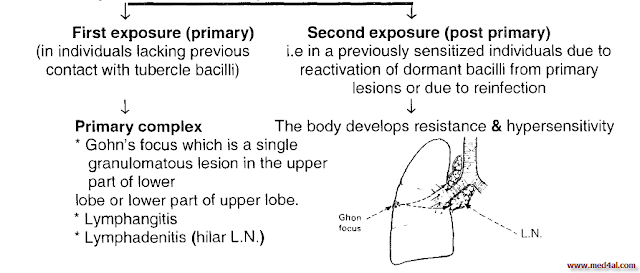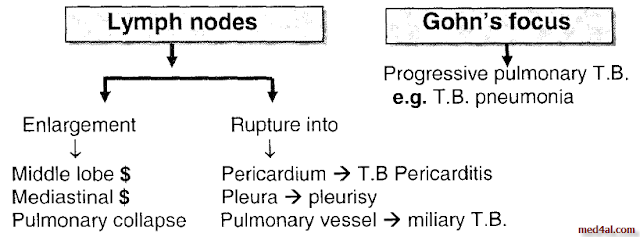This is an approach to Pulmonary Tuberculosis (T.B) , regarding its definition, causative organism, risk factors, people at risk and pathological types .
What is the causative organism in Pulmonary T.B?
Mycobacterium tuberculosis .
2- Mycobacterium bovis is endemic in cattle and spread to man through infected milk causing gastrointestinal tuberculosis.
3- Atypical mycobacterium (non tuberculous mycobacteria).
It leads to +ve tuberculin test.
It is common in immunopomromised patients, causing disseminated infection syndromes rather than tuberculosis in such patients.
ex. * M. Marinum * M. Kansasii
* M. Avium (important cause of pulmonary infection in patients with HIV).
* Children * Contacts * Patients with silicosis
* Immunocompromised patients
* Living in overcrowding with poor housing
• Entry of the organism through respiratory tract through inhalation of infected droplets produced by the coughing or sneezing of infected individuals.
After entry into the lungs, tubercle bacilli are ingested by macrophages and transported to regional lymph nodes, then it may disseminate widely.
Pathology of T.B
• The reaction of the body towards tubercle bacilli depends on the individual's hypensensitivty, resistance and whether those bacilli are first seen by the body or it is the second exposure so if :
• Primary infection < 1 year previously .• Chronic lung disease. Alcoholism
• Associated diseases e.g. silicosis, HIV, OM, CRF, liver cirrhosis, Lymphoma, Leukaemia, GIT disorders associated with malnutrition e.g. malabsorption disease.
• Patients under immunosuppressive drugs.
- Complete resolution by fibrosis and caicification.
- Incomplete(dormant Gohn's focus) i.e. healing for months or years then reactivation occurs,
e.g. during periods of low resistance ===> Exacerbation
2-Hypersensitivity : Erythema nodosum. • Phylectinular conjunctivitis • Pleural effusion
3- Progression of primary complex (Gohn's focus and L.N):
• Post primary tuberculosis is generally found in the apices of the lungs, reflecting the preference of M. tuberculosis for high O2 levels, these lesions may progress to
one of the following :
What is Pulmonary Tuberculosis ?
Pulmonary tuberculosis is a chronic communicable disease caused by mycobacterium tuberculosis characterized by a necrotizing (caseating) granuloma as a tissue response to seeded organisms.What is the causative organism in Pulmonary T.B?
Mycobacterium tuberculosis .
Types of mycobacteria
1- Mycobacterium tuberculosis, it causes most of cases of tuberculosis.2- Mycobacterium bovis is endemic in cattle and spread to man through infected milk causing gastrointestinal tuberculosis.
3- Atypical mycobacterium (non tuberculous mycobacteria).
It leads to +ve tuberculin test.
It is common in immunopomromised patients, causing disseminated infection syndromes rather than tuberculosis in such patients.
ex. * M. Marinum * M. Kansasii
* M. Avium (important cause of pulmonary infection in patients with HIV).
Who are the people at risk for Pulmonary Tuberculosis ?
• Those at high risk of acquiring T.B .* Children * Contacts * Patients with silicosis
* Immunocompromised patients
* Living in overcrowding with poor housing
• Entry of the organism through respiratory tract through inhalation of infected droplets produced by the coughing or sneezing of infected individuals.
After entry into the lungs, tubercle bacilli are ingested by macrophages and transported to regional lymph nodes, then it may disseminate widely.
Pathology of T.B
• The reaction of the body towards tubercle bacilli depends on the individual's hypensensitivty, resistance and whether those bacilli are first seen by the body or it is the second exposure so if :
Factors increasing the risk of tuberculosis:
• Children • Close contacts of patients with positive smear.for T.B.• Primary infection < 1 year previously .• Chronic lung disease. Alcoholism
• Associated diseases e.g. silicosis, HIV, OM, CRF, liver cirrhosis, Lymphoma, Leukaemia, GIT disorders associated with malnutrition e.g. malabsorption disease.
• Patients under immunosuppressive drugs.
A. Pathology of primary T.B complex and its Fate
1-Healing , either :- Complete resolution by fibrosis and caicification.
- Incomplete(dormant Gohn's focus) i.e. healing for months or years then reactivation occurs,
e.g. during periods of low resistance ===> Exacerbation
2-Hypersensitivity : Erythema nodosum. • Phylectinular conjunctivitis • Pleural effusion
3- Progression of primary complex (Gohn's focus and L.N):
B. Pathology of post-primary T.B
The term post - primary TB is usually due to one of the followings :• Post primary tuberculosis is generally found in the apices of the lungs, reflecting the preference of M. tuberculosis for high O2 levels, these lesions may progress to
one of the following :



